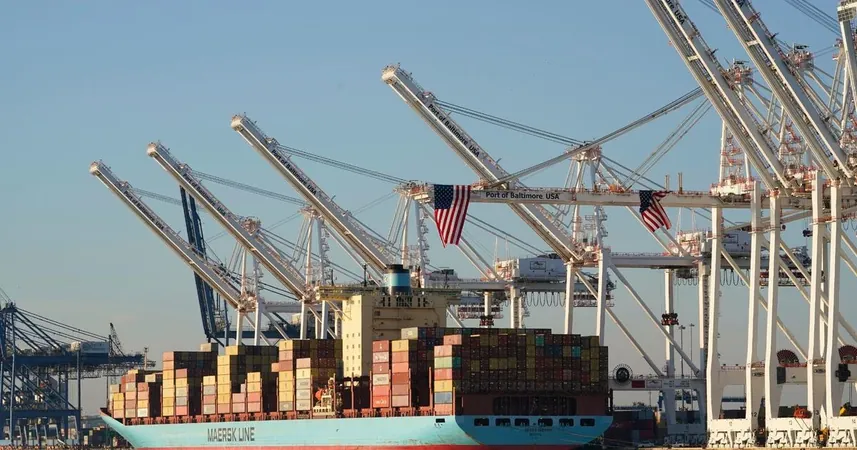
East Coast Dockworkers Set to Strike: Key Facts and Potential Consequences
2024-09-26
Author: Ying
As East Coast Dockworkers Gear Up for a Strike, Major Economic Impact Looms!
Starting early next week, thousands of dockworkers at every major port along the East and Gulf coasts are preparing for a potential strike— marking the first mass work stoppage at these ports since 1977. This move could jeopardize critical trade routes that manage about half of all U.S. containerized goods, posing a significant threat to the American economy.
The conflict centers around stalled negotiations between the International Longshoremen's Association (ILA), representing 45,000 dockworkers, and the United States Maritime Alliance (USMX), which includes terminal operators and shipping lines. Union leaders have threatened to halt operations at 36 ports if a new labor agreement is not reached by the current contract's expiration at midnight on September 30.
What’s fueling this impasse? Primarily, it boils down to wage disparities. East Coast dockworkers earn a base wage of $39 an hour after six years, significantly less than their West Coast counterparts, who make $54.85—a figure set to rise to $60.85 in 2027. The ILA’s demands include a staggering 77% wage increase over the next six years to align with recent inflation rates. Despite USMX’s claims of offering an "industry-leading" pay hike, the two sides remain far apart.
Broader Implications of a Strike
If the strike occurs, it will impact over 68% of containerized exports and 56% of imports in the U.S. Analysts warn that the economic fallout could reach $5 billion daily. This disruption could lead to traffic bottlenecks as freight is rerouted to West Coast ports, significantly straining those facilities as they are unable to absorb the entire cargo overflow.
Industries reliant on East Coast ports—such as automotive and pharmaceuticals—could face critical shortages of parts and essential goods, hindering production. Furthermore, disruptions in shipping vital consumer goods like food and electronics could result in increased prices and potential spoilage of perishables.
Despite these threats, consumers may not feel immediate repercussions. Major retailers, anticipating a strike, have ramped up stock supplies to meet holiday demands. Experts argue that while imports are currently running ahead of last year's pace by 10%, any prolonged strike will still have measurable consequences on supply chains.
Political Landscape and Possible Resolutions
In the political arena, recent U.S. labor history suggests that government intervention could be on the horizon. Under the Taft-Hartley Act, President Biden has the authority to impose an 80-day cooling-off period in case of a strike that threatens public welfare. While Biden’s administration is monitoring the situation closely, no immediate intervention plans have been communicated.
However, with the upcoming presidential election and intense competition for the labor vote, the administration may face pressure to resolve this dispute swiftly. Past interventions, such as the prevention of a railroad strike in 2022, indicate that action may be taken to avoid significant economic disruption.
As the situation develops, both dockworkers and observers remain anxious. The rhetoric has escalated, with ILA President Harold Daggett firmly stating, "We’ll shut them down October 1 if we don’t get the kind of wages we deserve." With all eyes on the East Coast ports, the outcome of these negotiations will be critical in shaping the future of American labor relations and economic stability.
Stay tuned as we continue to track this developing story and its implications for both workers and consumers alike!


 Brasil (PT)
Brasil (PT)
 Canada (EN)
Canada (EN)
 Chile (ES)
Chile (ES)
 Česko (CS)
Česko (CS)
 대한민국 (KO)
대한민국 (KO)
 España (ES)
España (ES)
 France (FR)
France (FR)
 Hong Kong (EN)
Hong Kong (EN)
 Italia (IT)
Italia (IT)
 日本 (JA)
日本 (JA)
 Magyarország (HU)
Magyarország (HU)
 Norge (NO)
Norge (NO)
 Polska (PL)
Polska (PL)
 Schweiz (DE)
Schweiz (DE)
 Singapore (EN)
Singapore (EN)
 Sverige (SV)
Sverige (SV)
 Suomi (FI)
Suomi (FI)
 Türkiye (TR)
Türkiye (TR)
 الإمارات العربية المتحدة (AR)
الإمارات العربية المتحدة (AR)